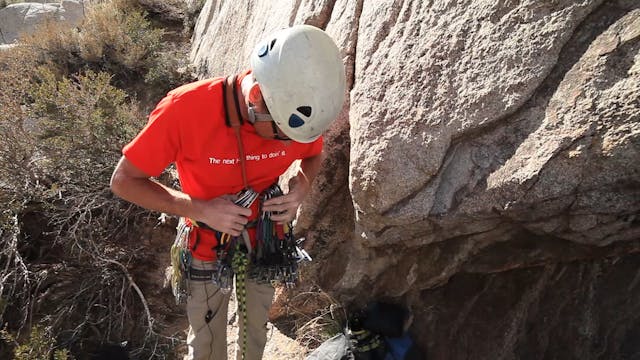Basic & Intermediate Outdoor Climbing: 15. How To Coil the Rope - Butterfly Coil
Basic & Intermediate Outdoor Climbing
•
2m 11s
In this video we review how to coil the rope using a butterfly coil. This is a great coil for carrying the rope like a backpack and is very useful when walking down from a multi pitch climb or walking off the top of a crag after top-roping.
Step 1: Line up both ends of the rope and measure two full arms lengths of slack (this may need fine tuning depending on the size of the climber and the thickness of the rope).
Step 2: Drape the rope over your neck, and start to make lap coils (these types of coils go back and forth instead of in a circle like when coiling an extension cord or hose). Use the length of each arm to keep the length of each coil consistent (see video above for demonstration).
Step 3: When you run out of rope, take the whole pile (or coil) of rope off your neck, letting both sides fall parallel. Holding the midpoint in your hand where your neck just was, start to wrap the slack around both sides of the coil. Start low and wrap upwards. You will close off a hole in the coil that looks like an alien head.
Step 4: Several feet before you reach the end of the rope, create a bight and push it through the hole or fold in the coil (that “alien head”), where your neck was and where your hand has been holding firmly. Pull the ends of the rope through the bight on the other side, so it rests over the top of your coil and fixes the whole thing in place.
Step 5: Throw the rope over your back and wrap the two tail ends around your body so that it is (relatively) comfortable and looks and feels (somewhat) like a backpack. Secure the tails around your belly using a square knot.
We hope you found this video helpful. Feel free to comment below with questions or thoughts!
Please remember, climbing is inherently dangerous. Climb at your own risk.
Up Next in Basic & Intermediate Outdoor Climbing
-
Basic & Intermediate Outdoor Climbing...
In this video we look at ways for the lead climber to rack for their climb. Here are a few tips from our pros:
1. First, consult a guidebook, topo, or other climbers to find out what sizes and types of gear you need to safely protect the route.
2. Shoulder length slings can be worn over you...
